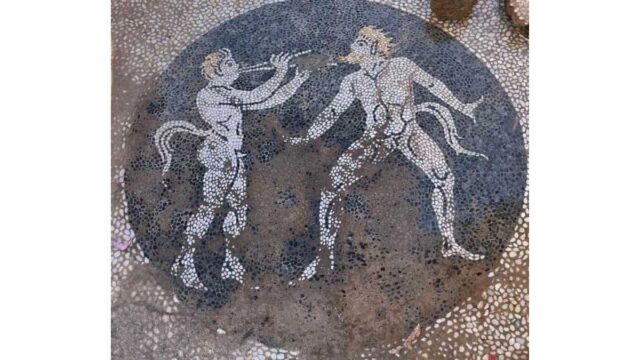Each find has shed light on different aspects of ancient civilizations and their culture. Here’s why they are significant.
It has been a week full of archaeological discoveries in Europe: They have unearthed a greek mosaic and a etruscan temple and new research has been published on ingots found in Spain.
Each discovery has shed light on different aspects of ancient civilizations and its culture. Its importance is explained below.
Archaeologists discover 2,700-year-old Etruscan temple in Tuscany
archaeologists of the Italian region of Tuscany have unearthed a 2,700-year-old Etruscan temple in the Sasso Pinzuto necropolis. The cult building is one of the largest of its kind and measures 6.2 by 7.1 meters.
The excavation was carried out by the Center for Ancient Mediterranean and Near Eastern Studies (CAMNES) in collaboration with the University of Naples Federico II.
The team found “tuffaceous opus quadratum” foundations (an ancient Roman construction technique with square blocks of stone) of a rectangular structure, known as oikos, which means house of the deity.
The discovery will shed light on the funerary cults in Tuscania during the Archaic period. Burial mounds and trenches for cult activities were also found nearby.
“In all likelihood, the oikos of Sasso Pinzuto will become a reference for funerary cults in archaic Etruscan necropolises,” declared Professor Alessandro Naso of the University of Naples.
The Sasso Pinzuto site has been excavated since the mid-19th century and houses more than 120 chamber tombs dating from as early as the 7th century BC
Greek mosaic of naked satyrs discovered in Euboea
On the Greek island of Euboea, archaeologists have discovered a mosaic floor which he tripped over during some water pipe installation work.
The modern town of Eretria houses the remains of an ancient greek city from the middle of the first millennium BC.
The extraordinary work of art represents two naked satyrs. The figures are half human, half animal, with goat or horse features including a tail, pointed ears, and horns.
In Greek mythology, satyrs were human-animal hybrid spirits closely related to the cult of Dionysus, god of fertility, wine, spiritual ecstasy and wild frenzy.
In the mosaic, a satyr plays a double flute while his older, bearded companion dances. The mosaic was discovered inside a house from the 4th century BC., located in the center of the ancient city and probably owned by a wealthy family.
The mosaic It is in “excellent condition” and the pebble design “gives realism and vitality to the figures in the show,” according to a statement from the Greek Ministry of Culture.
Researchers say lead poisoning played a role in the fall of the Roman Empire
During the construction works of a gas pipeline in Spain discovered a treasure of Roman lead ingots.
The discovery, in the north of Córdobaallows us to understand why the trade in this toxic metal could influence the fall of the Empire.
Three triangular ingots weighing between 24 and 32 kg were unearthed last century during the construction of the Maghreb-Europe gas pipeline.
A new investigation published in the ‘Journal of Roman Archeology’ has concluded that this site was the main lead smelting center of the ancient western world.
During the Roman Empire, metal was used to make kitchen utensils and water pipes. Some wealthy Romans also sweetened their wine with lead acetate.poisoning himself without knowing it.
Some historians believe that the frequent cases of lead poisoning of the empire’s rulers contributed to its final collapse.







